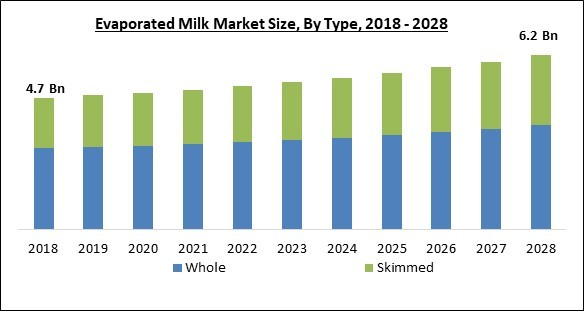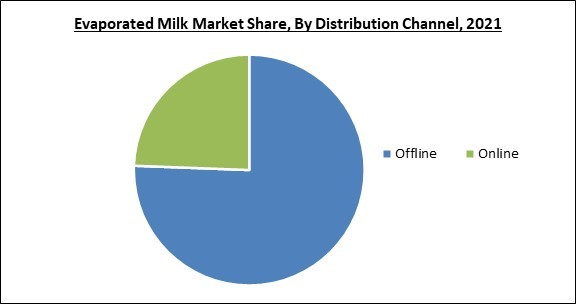The Global Evaporated Milk Market size is expected to reach $6.2 billion by 2028, rising at a market growth of 3.3% CAGR during the forecast period.
Evaporated milk is fresh milk that has been compressed, till its 60% of water content is removed. Consumers also enjoy unsweetened condensed milk, which is made from evaporated milk. Due to its widespread use in numerous end-use food goods and beverages, including coffee, shakes, and others, evaporated milk demand is rising in the milk market.
Evaporated milk, often known as dehydrated milk, is healthier than ordinary milk in many ways. All other nutritious benefits are kept even though this product's preparation removes about 60% of the water content of milk. The substance is then sterilized, homogenized, and added vitamins like vitamin D to make it stronger. In addition to calcium, iron, and vitamins C and A, evaporated milk is more nutrient-denser than fresh, powdered, or condensed milk.
Demand for milk in nations where the product supply is inadequate and of poor quality is also credited with driving market expansion. If refrigeration is not available in the area, evaporated milk is a useful substitute for ordinary milk because users do not have to worry about deterioration or disease, which is commonly caused by consuming dairy products that have expired. The evaporated varieties are preferred by both consumers and food service operators because they are more affordable than dairy whiteners.
Evaporated milk is also useful for hiking, camping, and traveling. In general, this product has a significantly longer shelf life and doesn't require refrigeration. Additionally, because it is light, clean, and doesn't need any specific packaging for containers, it is simpler to transport. However, since evaporated milk is a by-product of ordinary milk, any changes in the cost of the upstream good will have an impact on the price of evaporated milk production. This may significantly impede market expansion.
The market research report covers the analysis of key stake holders of the market. Key companies profiled in the report include Royal FrieslandCampina N.V., Nestle S.A., Arla Foods Amba, Fraser and Neave, Limited, Premier Foods PLC, DANA Dairy Group Ltd., Delta Food Industries FZC, Eagle Family Foods Group LLC, Yotsuba Milk Products Co., Ltd., and Alokozay Group of Companies.
Evaporated milk is fresh milk that has been compressed, till its 60% of water content is removed. Consumers also enjoy unsweetened condensed milk, which is made from evaporated milk. Due to its widespread use in numerous end-use food goods and beverages, including coffee, shakes, and others, evaporated milk demand is rising in the milk market.
Evaporated milk, often known as dehydrated milk, is healthier than ordinary milk in many ways. All other nutritious benefits are kept even though this product's preparation removes about 60% of the water content of milk. The substance is then sterilized, homogenized, and added vitamins like vitamin D to make it stronger. In addition to calcium, iron, and vitamins C and A, evaporated milk is more nutrient-denser than fresh, powdered, or condensed milk.
Demand for milk in nations where the product supply is inadequate and of poor quality is also credited with driving market expansion. If refrigeration is not available in the area, evaporated milk is a useful substitute for ordinary milk because users do not have to worry about deterioration or disease, which is commonly caused by consuming dairy products that have expired. The evaporated varieties are preferred by both consumers and food service operators because they are more affordable than dairy whiteners.
Evaporated milk is also useful for hiking, camping, and traveling. In general, this product has a significantly longer shelf life and doesn't require refrigeration. Additionally, because it is light, clean, and doesn't need any specific packaging for containers, it is simpler to transport. However, since evaporated milk is a by-product of ordinary milk, any changes in the cost of the upstream good will have an impact on the price of evaporated milk production. This may significantly impede market expansion.
COVID-19 Impact Analysis
Nearly every business has been impacted by the unmatched public health emergency known as COVID-19, and the long-term impacts are expected to influence industry growth throughout the forecast period. To assure the incorporation of underlying COVID-19 concerns and potential future directions, the continuous study expands the on research approach. The paper provides information on COVID-19 considering changes in consumer demand and behavior, buying habits, supply chain rerouting, dynamics of contemporary market forces, and significant government initiatives. The supply chain for raw materials, the transit of finished goods, and interrupted processes all experienced significant disruptions that affected the milk business.Market Growth Factors
Growing Consumption Of Evaporated Milk In Food And Drinks
The demand for evaporated milk in domestic applications is rising in the market for evaporated milk. In the food and beverage sector, there is a rising demand for evaporated milk. Additionally, the bakery and confectionery industries have seen a notable rise in demand for evaporated milk. Evaporated milk is primarily used in the food and beverage industries to process food and create milk-based beverages. It is additionally utilized in baby food. The demand for evaporated milk in bakery goods and milk-based confections is rising in the bakery and confectionery sector.Demand For Low Cholesterol Diet Foods Is Growing
Food manufacturers internationally are working to provide food products that meet consumers' expectations for both taste and health advantages as they seek healthier foods. When making curry and rendang, evaporated full milk works perfectly in place of coconut milk. Without sacrificing flavor, evaporated full milk is a better substitute that is cholesterol-free. Because milk is regularly consumed, the market is expected to undoubtedly expand once such milk with so many health advantages is introduced.Market Restraining Factors
Harmful Effects On Diabetes And Heart Patients
Sweetened condensed milk is high in calories, but it's also high in saturated fat, which is dangerous for people with diabetes and heart problems. The levels of LDL cholesterol and insulin may rise as a result of a diet high in saturated fats, according to studies. Cardiovascular problems are more likely to occur when LDL cholesterol levels are high. As a result, the body may be unable to break down the sugar that causes type 2 diabetes. Additionally, it may result in a rise in insulin resistance. Type 2 diabetes has been much more common during the past 3 decades in nations of all levels of income.Type Outlook
Based on type, the evaporated milk market is bifurcated into Skimmed and Whole. The whole segment acquired the highest revenue share in the evaporated milk market in 2021. It is because the candy business uses this variation frequently. Because it has a creamy texture and flavor without the sweetness of condensed milk, it is frequently used in quiches, soups, béchamel sauce, gravies, and other goods.Distribution Channels Outlook
On the basis of distribution channels, the evaporated milk market is categorized into Online and Offline. The online segment registered a substantial revenue share in the evaporated milk market in 2021. It is because evaporated milk sales online are being fueled by elements like a rise in consumer awareness of businesses' online presence, the international adoption of the internet, the accessibility of a variety of discounts and offers, and access to product details, specs, and usage guides.Regional Outlook
Region-wise, the evaporated milk market is analyzed across North America, Europe, Asia Pacific, and LAMEA. The Europe region garnered the highest revenue share in the evaporated milk market in 2021. It is due to a rise in the popularity of low-fat and sugar dairy products. This is a result of the British Retail Consortium's mandated limitations on unhealthy food. The U.K. accounted for about 12.0 percent of the market in 2018, making it the largest and quickest market in the area.The market research report covers the analysis of key stake holders of the market. Key companies profiled in the report include Royal FrieslandCampina N.V., Nestle S.A., Arla Foods Amba, Fraser and Neave, Limited, Premier Foods PLC, DANA Dairy Group Ltd., Delta Food Industries FZC, Eagle Family Foods Group LLC, Yotsuba Milk Products Co., Ltd., and Alokozay Group of Companies.
Scope of the Study
Market Segments Covered in the Report:
By Type
- Whole
- Skimmed
By Distribution Channel
- Offline
- Online
By Geography
- North America
- US
- Canada
- Mexico
- Rest of North America
- Europe
- Germany
- UK
- France
- Russia
- Spain
- Italy
- Rest of Europe
- Asia Pacific
- China
- Japan
- India
- South Korea
- Singapore
- Malaysia
- Rest of Asia Pacific
- LAMEA
- Brazil
- Argentina
- UAE
- Saudi Arabia
- South Africa
- Nigeria
- Rest of LAMEA
Key Market Players
List of Companies Profiled in the Report:
- Royal FrieslandCampina N.V.
- Nestle S.A.
- Arla Foods Amba
- Fraser and Neave, Limited
- Premier Foods PLC
- DANA Dairy Group Ltd.
- Delta Food Industries FZC
- Eagle Family Foods Group LLC
- Yotsuba Milk Products Co., Ltd.
- Alokozay Group of Companies
Unique Offerings from the Publisher
- Exhaustive coverage
- The highest number of Market tables and figures
- Subscription-based model available
- Guaranteed best price
- Assured post sales research support with 10% customization free
Table of Contents
Chapter 1. Market Scope & Methodology
Chapter 2. Market Overview
Chapter 3. Global Evaporated Milk Market by Type
Chapter 4. Global Evaporated Milk Market by Distribution Channel
Chapter 5. Global Evaporated Milk Market by Region
Chapter 6. Company Profiles
Companies Mentioned
- Royal FrieslandCampina N.V.
- Nestle S.A.
- Arla Foods Amba
- Fraser and Neave, Limited
- Premier Foods PLC
- DANA Dairy Group Ltd.
- Delta Food Industries FZC
- Eagle Family Foods Group LLC
- Yotsuba Milk Products Co., Ltd.
- Alokozay Group of Companies
Methodology

LOADING...










